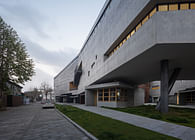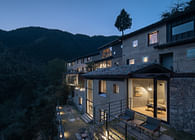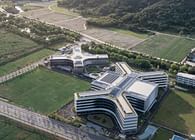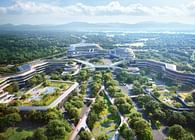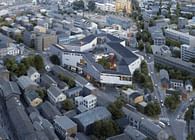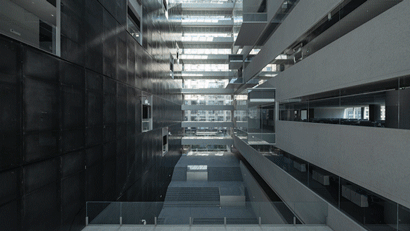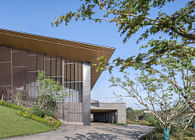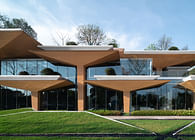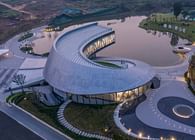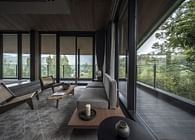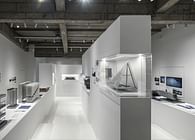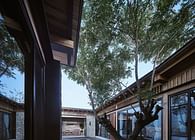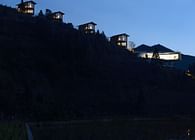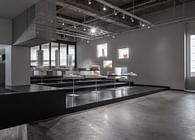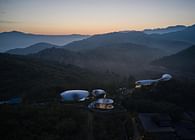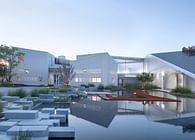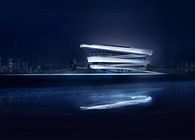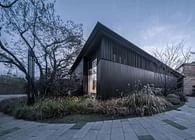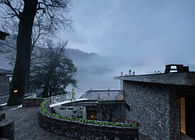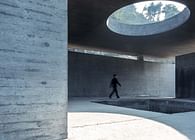
LOFT49, located on the banks of the Grand Canal in Hangzhou, traces its origins back to the Hangzhou Chemical Fiber Factory founded in 1958, which evolved into the Peacock Nylon Factory in the 1980s. In 2003, the abandoned factory buildings attracted a large number of artists who spontaneously gathered, giving birth to Hangzhou's first iconic creative park, LOFT49. The park continued to operate until 2019 when it began its upgrading and renovation. Within the site, only the structurally sound 6th and 10th buildings with well-preserved industrial features were retained.
Dr. Zhu Peidong, Co-Founder and Chief Architect of line+ studio, along with the team, secured the rights for the overall planning, comprehensive park scheme, and integrated interior renovation of the industrial heritage buildings in the second phase of the LOFT49 park. In collaboration with CCIHC, they are creating a model area for industrial rejuvenation along the Grand Canal, combining domestic and international expertise.
The renewal of industrial heritage is not only a tribute to history but also a service to the present and a vision for the future. We choose the "Jinshan (Gold Sealing)" approach to inject unique vitality into the inefficient land in the urban center, combining historical memory with contemporary spirit. - Zhu Peidong
Having gone through a comprehensive renovation from an industrial park to an industrial heritage site and further into a creative industry park, LOFT49 now faces a dual challenge of how to protect, renew, and efficiently enhance the spatial capacity of industrial heritage in a prime urban location while adapting to evolving industries. Therefore, based on their research in urban renewal, line+ has introduced the overarching planning concept of "Urban Jinshan (Gold Sealing), Vitality District." This concept aims to leverage urban memories to reinvigorate public spaces and empower the renewal of inefficient urban areas. By expanding building capacity, upgrading commercial formats, evolving industrial forms, compensating for public spaces, and creating a vibrant block capable of accommodating diverse activities in the future.
01 Urban Jinshan (Gold Sealing):
From Enclosed Park to Vibrant District
The design team conducted extensive research on the site, exploring cultural heritage, physical spaces, and blcok characteristics to emphasize the unique significance of LOFT49's industrial heritage and creative genes in Hangzhou’s urban development. The planning layout follows the factory's existing context, emphasizing centrality with the heritage buildings as the central axis. Additional building capacity is introduced only on the periphery while maintaining control over the size and scale of new constructions, creating a welcoming and accessible urban interface.
The building's form is fractally designed, resembling a windmill, to create flexible rental units that cater to a diverse range of market needs, from startups to established companies. By reducing the building's volume, it enhances the sense of a blcok scale. The exterior facade of the office building is adorned with deep red glazed ceramic panels and ceramic bars, harmonizing with the overall color scheme of the district and creating a distinctive architectural expression.
02 Industrial Relics Regeneration:
From Static Space to Dynamic Platform
Building 10, constructed in 1987, served as the primary production facility of the original factory, featuring a typical steel truss structure with a large span, and retaining pioneering industry-specific equipment. Building 6, erected in 1990, was initially a production workshop for acrylic socks, preserving some production equipment. During the cultural and creative park phase, artists mainly carried out minor modifications, such as wall painting and the expansion of window openings. The primary principle in the current renovation phase is to maintain authenticity and enhance the buildings' performance and functionality with minimal intervention.
The architects employed a " Jinshan (Gold Sealing)" renewal strategy involving integration, intervention, and connection to establish a sense of wholeness and sequence in both public buildings in terms of form, function, and experience. By revisiting the superimposed legacies spanning two different eras and the existing production facilities, they transformed the original production flow into spatial circulation. Based on the original spatial layout, they repurposed old functions into new ones, renewing the external appearance accordingly. At a height of 11.850 meters, a bridge pathway connects the buildings, creating a comprehensive exhibition narrative rooted in the industrial production heritage.
The north and south facades of Building 10 maintain a typical industrial style, preserving window openings, wall surfaces, and selective modifications from the cultural and creative park era. The central entrance has been expanded into a public courtyard, and portions of the eastern and western facades have been partially opened to showcase the truss structure and facility equipment in a sectional manner, reinforcing the trusses and side walls. A new weather-resistant roof system, supported by 16 grid columns, has been introduced, creating a rare urban central rooftop garden. Building 6 retains its varied building forms, facade window openings, and industrial pipelines. The interior spaces revolve around the retained production equipment, with sections of walls opened up and weather-resistant steel plates and microcement finishes incorporated. This results in a dialogue between the old and new systems, creating an entirely new industrial museum experience.
03 Business Evolution:
From Single-Dimensional Inefficiency to Multi-Dimensional Complexity
With the iteration of new industries and lifestyle scenarios, architectural spaces are now demanding higher levels of flexibility, variability, adaptability, accessibility, and sustainability. The traditional, single-dimensional, and audience-limited model of the cultural and creative park is no longer suitable for LOFT49's development. Therefore, the architects have adopted an adaptive spatial design and a diversified business strategy to cater to the needs and characteristics of urban dwellers in the new era. The architectural program is no longer limited to traditional office spaces; by incorporating elements of L-W-P (Life-Work-Play), it attracts diverse industries to spontaneously gather, welcomes artists back, and transforms into a dynamic, new mixed-use district, shaping a new industrial landmark in Hangzhou.
04 Remark
LOFT49, one of the significant industrial heritage renewal projects in the heart of Hangzhou, has undergone years of heritage assessment, operational planning, and design deliberations. The final scheme, after multiple rounds of expert scrutiny, has been solidified. This project marks the inauguration of line+'s "Urban Jinshan (Gold Sealing)" initiative, aiming to revitalize industrial spaces, preserve urban memories, and utilize architecture as a catalyst to activate the complex organic ecosystem of the city, ultimately rejuvenating the urban landscape.
Status: Built







